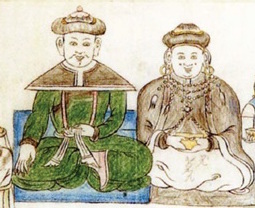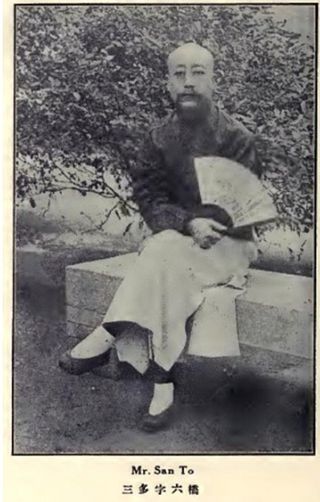
Outer Mongolia was the name of a territory in the Manchu-led Qing dynasty of China from 1691 to 1911. It corresponds to the modern-day independent state of Mongolia and the Russian republic of Tuva. The historical region gained de facto independence from Qing China during the Xinhai Revolution.

Oirats or Oirds, formerly known as Eluts and Eleuths, are the westernmost group of the Mongols, whose ancestral home is in the Altai region of Siberia, Xinjiang and western Mongolia.

The Khalkha have been the largest subgroup of the Mongols in modern Mongolia since the 15th century. The Khalkha, together with Chahars, Ordos and Tumed, were directly ruled by Borjigin khans until the 20th century; unlike the Oirats, who were ruled by Dzungar nobles or the Khorchins, who were ruled by Qasar's descendants.

Tannu Uriankhai was a historical region of the Mongol Empire, its principal successor, the Yuan dynasty, and later the Qing dynasty. The territory of Tannu Uriankhai largely corresponds to the modern-day Tuva Republic of the Russian Federation, neighboring areas in Russia, and a small part of the modern state of Mongolia.

Öndör Gegeen Zanabazar was the first Jebtsundamba Khutuktu and the first Bogd Gegeen or supreme spiritual authority, of the Gelugpa lineage of Tibetan Buddhism in Mongolia.

The Bogd Khan Mountain is a mountain in Mongolia that overlooks the nation's capital, Ulaanbaatar, from a height of 2,261 metres (7,418 ft) to the south of the city.

Chingünjav (Mongolian: Чингүнжав, Chinese: 青袞雜卜; also known as Admiral Chingün was the Khalkha prince ruler of the Khotogoids and one of the two major leaders of the 1756-57 rebellion in Outer Mongolia. Although his rebellion failed, he is nowadays often hailed as a fighter for Outer Mongolia's independence from the Manchu-led Qing dynasty of China.

Mongolia under Qing rule was the rule of the Manchu-led Qing dynasty of China over the Mongolian Plateau, including the four Outer Mongolian aimags and the six Inner Mongolian aimags from the 17th century to the end of the dynasty. The term "Mongolia" is used here in the broader historical sense, and includes an area much larger than the modern-day state of Mongolia. By the early 1630s Ligdan Khan saw much of his power weakened due to the disunity of the Mongol tribes. He was subsequently defeated by the Later Jin dynasty and died soon afterwards. His son Ejei handed the Yuan imperial seal over to Hong Taiji in 1635, thus ending the rule of the Northern Yuan dynasty in Inner Mongolia. However, the Khalkha Mongols in Outer Mongolia continued to rule until they were overrun by the Dzungar Khanate in 1690, and they submitted to the Qing dynasty in 1691.

The Zakhchin is a subgroup of the Oirats residing in Khovd Province, Mongolia. Zakhchin means 'Border people'. They are so called because they originated from the border garrison of the Dzungar Khanate. They originally spoke the Zakhchin dialect of the Oirat language, but actually pure Oirat language is used by elder generations, younger generations use a dialect being under a strong Khalkha influence.

The Northern Yuan was a dynastic state ruled by the Mongol Borjigin clan based in the Mongolian Plateau. It existed as a rump state after the collapse of the Yuan dynasty in 1368 and lasted until its conquest by the Jurchen-led Later Jin dynasty in 1635. The Northern Yuan dynasty began with the retreat of the Yuan imperial court led by Toghon Temür to the Mongolian steppe. This period featured factional struggles and the often only nominal role of the Great Khan.
Various nomadic empires, including the Xiongnu, the Xianbei state, the Rouran Khaganate (330–555), the First (552–603) and Second Turkic Khaganates (682–744) and others, ruled the area of present-day Mongolia. The Khitan people, who used a para-Mongolic language, founded an empire known as the Liao dynasty (916–1125), and ruled Mongolia and portions of North China, northern Korea, and the present-day Russian Far East.
An aimag, originally a Mongolian word meaning 'tribe', is an administrative subdivision in Mongolia, Russia, and in the Inner Mongolia region of China.

Tserendondovyn Navaanneren was the 20th Khan of the hereditary Setsen Khanate located in the eastern third of modern-day Mongolia. His full title was "Mahasamadi Dalai Setsen Khan". The first Setsen Khan was Sholoi (1577–1655) of the Khalkha, who was a direct descendant of Genghis Khan through Batumongke Dayan Khan (1464–1543).

Mijiddorjiin Khanddorj, also known by his title Chin Van, or Chin Wang Khanddorj, was an aristocrat and prominent early 20th-century Mongolian independence leader. He served as the first minister of foreign affairs of the Bogd Khanate of Mongolia in the government of the Bogd Khan from 1911 to 1913 and founded the nation's diplomatic service. He died, allegedly poisoned, in 1915.
Gersenji (1513-1549) - alternately Geressandsa - was the 11th and youngest son of Dayan Khan and the second son with Jimsgene khatun. Having appointed over the Jalayir tribe as their ruler, Gersenji was named by his father as chief of the Khalkha Mongol tümen in northern Mongolia, which he ruled from the 1510s until his death in 1549.

Abtai Sain Khan - alternately Abatai or Avtai (Mongolian: Автай хан, meaning who have the gift of witchcraft and good - was a Khalkha-Mongolian prince who was named by the 3rd Dalai Lama as first khan of the Tüsheet Khanate in 1587. He zealously propagated Tibetan Buddhism among the Khalkha Mongols and founded the Buddhist monastery of Erdene Zuu in 1585.

Tüsheet Khan refers to the territory as well as the Chingizid dynastic rulers of the Tüsheet Khanate, one of four Khalka khanates that emerged from remnants of the Mongol Empire after the death of Dayan Khan's son Gersenji in 1549 and which continued until 1930.

Sando, courtesy name Liuqiao, was an official of the Qing dynasty and later the Republic of China who most served as the 62nd and last Qing Amban of Outer Mongolia from 1909 to 1911. Although ethnically a Mongol, Sando's aggressive implementation of Beijing ordered reforms, including increased immigration of ethnic Han to the area and a rapid buildup of a sinicized military to fend off growing Russian influence, aggravated Mongols and precipitated moves by Khalkha nobles to declare independence from China in 1911.

Sechen Khan, also spelled Setsen Khan, refers to the territory as well as the Chingizid dynastic rulers of the Secen Khanate. It was one of four Khalka khanates that emerged from remnants of the Mongol Empire after the death of Dayan Khan's son Gersenji Khongtaiji in 1549.

Sain Noyon Khan, known as Sain Noyon before 1911, refers to the territory as well as the Chingizid dynastic rulers of the Sain Noyon Khanate.
















